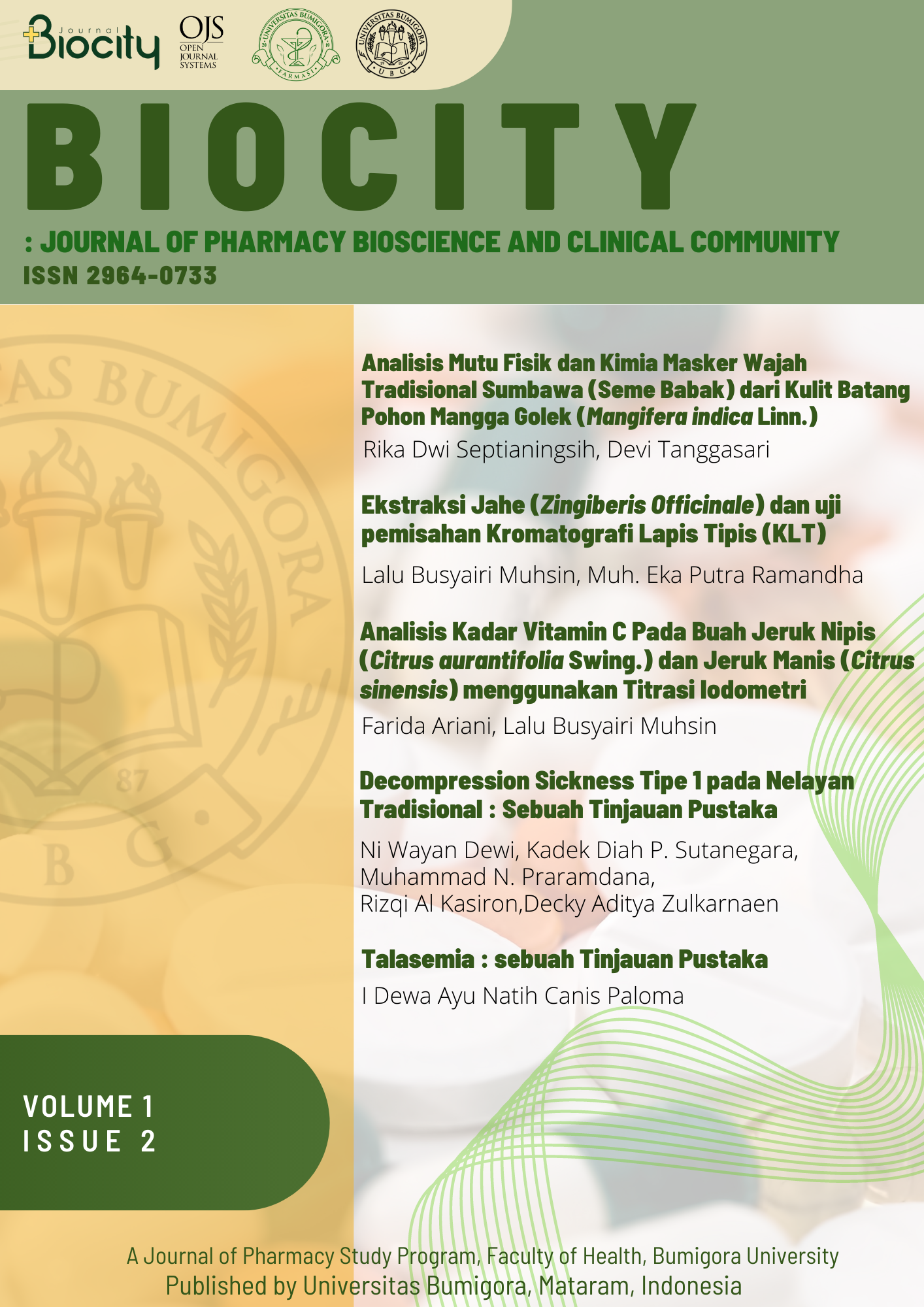Decompression Sickness Tipe 1 pada Nelayan Tradisional : sebuah Tinjauan Pustaka
Abstract
Decompression sickness (DCS) is a collection of symptoms caused by the formation of air bubbles in the blood or tissues during or after a decrease in environmental pressure (decompression). In general, the main symptoms of DCS type 1 (pain-only beds) are muscle pain and weakness. So to diagnose Decompression Disease (DCS) type 1, it is based on the symptoms and the history of diving. Type 1 decompression sickness is managed by choosing initial treatment in the form of giving 100% oxygen through a face mask or, if needed, through intubation. While hyperbaric oxygen therapy can be used for definitive therapy if it is available in primary or secondary health care facilities.
References
Blatteau J-E, Hugon J, Gempp E, Castagna O, Pény C, V. N. (2012). Oxygen breathing or recompression during decompression from nitrox dives with a rebreather: effects on intravascular bubble burden and ramifications for decompression profiles. Eur J Appl Physiol., 112:2257–6.
Chin W, Jacoby L, Simon O, Talati N, Wegrzyn G, J. R. (2016). Hyperbaric programs in the United States: Locations and capabilities of treating decompression sickness, arterial gas embolisms, and acute carbon monoxide poisoning: survey results. Undersea Hyperb Med, 43:29–43.
Cooper JS, H. K. (2022). Decompression Sickness. Treasure Island (FL): StatPearls.
Dujic Z, Duplancic D, Marinovic-Terzic I, Bakovic D, Ivancev V, V. Z. (2004). Aerobic exercise before diving reduces venous gas bubble formation in humans. J Physiol, 555:637–42.
Dujic Z, Valic Z, B. A. (2008). Beneficial role of exercise on scuba diving. Exerc Sport Sci Rev. 36:38–42.
Hisnindarsyah H, Usemahu SN, M. J. (2018). RESPON Pasien Dengan Decompression Sickness Tipe I Terhadap Pemberian Terapi Oksigen Hiperbarik Di RSAL DR.F.X Suhardjo Tahun 2016. Molucca Medica.
Jusmawati, J., Arsin, A. A., & Naiem, F. (2016). Faktor Risiko Kejadian Decompression Sickness Pada Masyarakat Nelayan Peselam Tradisional Pulau Saponda. Media Kesehatan Masyarakat Indonesia, 12(2), 63-69.
Linggayani, N. M. A., & Ramadhian, R. (2017). Penyakit Caisson pada Penyelam. Fakultas Kedokteran Universitas Lampung, 4(2), 1–6.
Longphre J, Denoble P, Moon R, Vann R, F. J. (2007). First aid normobaric oxygen for the treatment of recreational diving injuries. Undersea & Hyperbaric Medicine : Journal of the Undersea and Hyperbaric Medical Society, Inc, 34:43–9.
Mitchell SJ, Bennett MH, Bryson P, Butler FK, Doolette DJ, H. J. (2018). Consensus guideline: Pre-hospital management of decompression illness: expert review of key principles and controversies. Undersea Hyperb Med, 45:273–86.
Moon, R. E. (2021). Decompression Sickness In Duke University Medical Center.
Pollock, N. W., & Buteau, D. (2017). Updates in Decompression Illness. Emerg Med Clin North Am.
Pulley, S. A. (2019). Decompression Sickness. Medscape.
Russeng1 SS, Saleh1 LM, Syafar1 M, R. M. (2020). Decompression Sickness Indicators in Traditional Divers in Bajo, Boalemo District. Medico Legal Update.
Simon, Mitchell, & Bennet, M. (2022). Decompression sickness and arterial gas embolism. The New England Journal of Medicine, 4(3), 39–45. https://doi.org/10.1056/nejmra2116554
Wang F, Fang Y, You P, Bao X, Ma J, Z. S. (2015). Effect of different pressure oxygen pre-breathe in diving decompression sickness of rats. Zhongguo Ying Yong Sheng Li Xue Za Zhi, 31:401–4.
Wardoyo EH, Susani YP, Zulkarnaen DA, Widiastuti IAE, Dirja BT, S. D. (2022). Edukasi Penyelaman Aman bagi Nelayan Pesisir Montong Lombok Barat. J Pengabdi Magister Pendidik IPA, 5(2):128–3.
Wisloff U, B. A. (2001). Aerobic endurance training reduces bubble formation and increases survival in rats exposed to hyperbaric pressure. J Physiol, 537:607–11.

This work is licensed under a Creative Commons Attribution-ShareAlike 4.0 International License.














